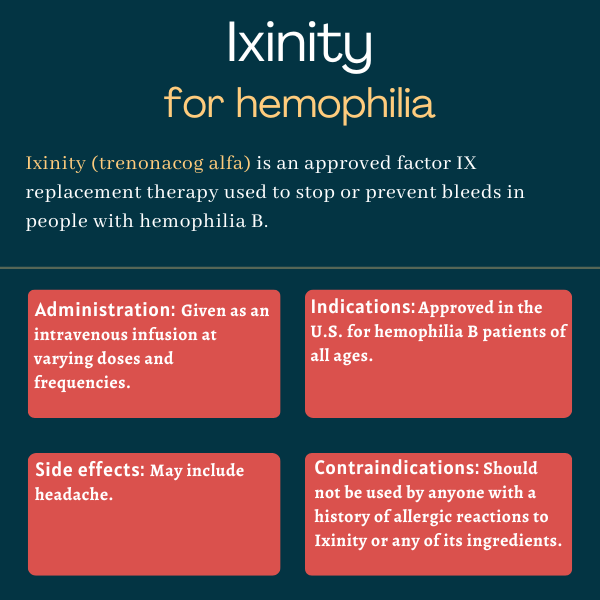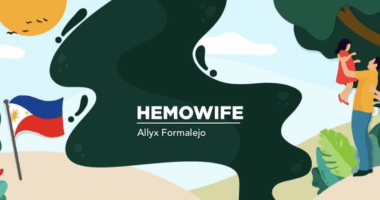Ixinity (trenonacog alfa) for hemophilia
What is Ixinity for hemophilia?
Ixinity (trenonacog alfa; IB1001) is an approved replacement therapy designed to prevent or treat bleeding episodes in hemophilia B patients of all ages.
The therapy is a recombinant, or lab-made, coagulation factor IX concentrate that works to improve clotting in hemophilia B patients. It is administered via an infusion into the vein, or intravenously.
Ixinity was originally developed by Aptevo Therapeutics, but the global rights to it were acquired by Medexus Pharmaceuticals in 2020. In 2023, Xoma purchased rights to part of the sales from the therapy in a deal with Aptevo.
Therapy snapshot
| Brand name: | Ixinity |
| Chemical name: | Trenonacog alfa |
| Usage: | Treatment and prevention of bleeds in children and adults with hemophilia B |
| Administration: | Intravenous infusion |
How does Ixinity work?
Hemophilia B is a bleeding disorder caused by a deficiency of one of the factors required for blood clotting, specifically, factor IX (FIX). As a result, blood clotting is impaired and patients may experience excessive and prolonged bleeding.
Ixinity is a lab-made version of human FIX designed to restore factor IX levels and allow normal blood clotting in hemophilia B patients.
The treatment is used on demand to control active bleeds, but also may be taken as a preventive (prophylactic) therapy to reduce the frequency of bleeding episodes. Ixinity also may be used to manage blood loss during surgery.
Who can take Ixinity?
The U.S. Food and Drug Administration (FDA) first approved Ixinity in April 2015 as an on-demand treatment for bleeds and to manage those that occur during surgery in adults and children, ages 12 and older, with hemophilia B. Later, the therapy was approved as a routine prophylactic treatment for adults and children of the same ages with hemophilia B.
The FDA again expanded Ixinity’s approval in March 2024 to include children younger than 12, making Ixinity available to treat and prevent bleeds in hemophilia B patients of all ages.
Who should not take Ixinity?
According to the therapy’s prescribing information, patients with a known sensitivity to Ixinity or any of its ingredients, including hamster proteins, should not use Ixinity.
The therapy also is not indicated for induction of immune tolerance, a treatment to re-educate a patient’s immune system to cease producing neutralizing antibodies, or inhibitors, against delivered clotting factors in hemophilia B patients.
How is Ixinity administered?
The therapy comes as a white to off-white powder in single-use color-coded glass vials that contain 250, 500, 1,000, 1,500, 2,000, or 3,000 international units (IU) of FIX. It should be reconstituted, or diluted, in sterile water and administered as an intravenous infusion.
Ixinity may be given by a healthcare provider or self-administered at home after proper training and instruction. Patients should never self-administer Ixinity unless they have been taught how to safely do so by a healthcare professional.
The appropriate dose and frequency of Ixinity will be determined by a clinician based on a patient’s age, body weight, clinical condition, physical activity levels, along with the type of bleed, bleeding severity, and degree of FIX deficiency.
For routine prophylaxis, Ixinity is typically administered twice a week at 40-70 IU per kilogram of body weight (IU/kg) in adolescents and adults ages 12 and older, and at 35-75 IU/kg for children younger than 12. These dosages may be adjusted by a doctor based on the factors described above.
For on-demand treatment, Ixinity is recommended to be given at varying intervals, depending on bleed severity, to maintain FIX activity levels within the desired range. Treatment is given until healing is achieved. For:
- Minor bleeds: dosing every 24 hours for 1-3 days to maintain FIX activity levels at 30-60 IU/dL
- Moderate bleeds: dosing every 24 hours for 2-7 days to maintain FIX activity levels at 40-60 IU/dL
- Major or life-threatening bleeds: dosing every 12-24 hours for 2-14 days to maintain FIX activity levels at 60-100 IU/dL.
For minor surgical procedures, the therapy should be given every 24 hours for 1-5 days after surgery to maintain FIX activity levels at 30-80 IU/dL. Before surgery, the medication should be given to ensure FIX activity levels are at 50-80 IU/dL.
For major surgical procedures, Ixinity should be given every 8-24 hours after surgery to maintain FIX activity levels at 40-60 IU/dL in the first three days. On days 4-6, it should be given to maintain FIX activity levels at 30-50 IU/dL, and then administered to keep FIX levels at 20-40 IU/dL from day seven to day 14. Before surgery, the medication should be given to ensure FIX activity levels are at 60-80 IU/dL.

Ixinity in clinical trials
Ixinity was approved for use in hemophilia B patients of all ages based on results from several clinical trials.
For adults and children ages 12 and older
A multicenter Phase 2/3 trial (NCT00768287) assessed Ixinity’s safety, efficacy, and pharmacokinetics, that is, its movement into, through, and out of the body, in 77 hemophilia B patients with severe or moderately severe disease. All had previously been treated with FIX replacement therapy.
The study’s first randomized, controlled part compared the pharmacokinetics of Ixinity against BeneFix (nonacog alfa), another FIX replacement therapy. It found the pharmacokinetics were comparable between the two treatments.
A second, open-label part evaluated Ixinity’s safety and effectiveness at controlling or preventing bleeds. The results showed that Ixinity was well tolerated. The most common side effect was headache. There were no reports of FIX inhibitors during treatment.
Ixinity was effective at preventing bleeds (prophylaxis treatment), with a median annual bleed rate of 1.52. It also effectively controlled bleeds, with one or two infusions able to resolve 84% of bleeds. Participants usually rated the treatment’s ability to control bleeds as excellent or good, and trial investigators deemed the treatment effective in more than 90% of cases.
Findings from a trial sub-study showed the treatment also was beneficial for surgical management. Surgeons rated Ixinity as adequate or better than adequate at controlling bleeds during 19 major surgeries.
For children younger than 12
An analysis of pooled data from two studies showed that Ixinity also was safe and well-tolerated in 12 children younger than age 12. The treatment also showed comparable efficacy to that in the earlier trial involving older patients.
Of 61 total bleeding episodes, six (10%) resolved with no infusions of Ixinity, and 44 (72%) resolved after one infusion. Five bleeding episodes (8%) required two infusions, and six (10%) required 3-5 infusions.
Participants rated bleed control as excellent in 65% of the bleeds, good in 32%, and fair in 3%. The most common side effect was excessive sweating, reported in two patients.
Ixinity’s approval for children younger than 12 was largely backed by data from a Phase 3/4 trial (NCT03855280) that tested the therapy in 21 previously treated children, all younger than 12, with moderately severe to severe hemophilia B. After an initial part to test the safety and pharmacological properties of a single dose, patients received one to two weekly infusions of Ixinity as prophylaxis. The medication could also be used on-demand for active bleeds.
Results showed the mean annual bleeding rate on Ixinity was 2.34 bleeds per year, with a mean spontaneous bleed rate of 0.63 per year. Seven children had no bleeds throughout the trial. More than 80% of the bleeds that occurred and required treatment during the study resolved with up to two infusions of Ixinity.
Ixinity’s efficacy for controlling bleeding was rated as excellent or good by participants in most cases.
No clinically meaningful differences were observed between children younger than 6 or those ages 6 and older. The therapy was generally well tolerated in these young patients.
Common side effects of Ixinity
The most common side effect of Ixinity reported in clinical trials was headache.
Allergic reactions
Allergic reactions, including anaphylaxis — a severe and life-threatening allergic reaction — have been reported in patients using Ixinity. Signs of an allergic reaction may include swelling, hives, chest or throat tightness, low blood pressure, lethargy, nausea, vomiting, difficulty swallowing, abnormal sensations, wheezing, or difficulty breathing.
Patients experiencing signs of an allergic reaction should seek medical care immediately.
Inhibitors
Some patients also may develop neutralizing antibodies, or inhibitors, against the treatment. This can reduce the medication’s effectiveness and make allergic reactions more likely. If expected FIX levels are not attained or bleeding is not controlled with Ixinity, it is recommended that a blood test for inhibitors be performed.
Kidney problems
Ixinity may cause nephrotic syndrome, a condition wherein too much protein is passed in the urine, usually as a result of kidney damage. Nephrotic syndrome is more likely in patients with a history of allergic reactions or inhibitor development.
Blood clots
Blood clots (thromboembolism) may occur when using Ixinity. Patients should be monitored for blood clots during treatment, with close observation given to those with liver disease, those who have undergone surgery, and those at an increased risk of clotting events.
Use in pregnancy and breastfeeding
No clinical or preclinical data exist regarding the use of Ixinity in pregnant patients or while breastfeeding. People with hemophilia B who are pregnant or wish to become pregnant when using Ixinity should discuss this with their healthcare team.
Hemophilia News Today is strictly a news and information website about the disease. It does not provide medical advice, diagnosis or treatment. This content is not intended to be a substitute for professional medical advice, diagnosis, or treatment. Always seek the advice of your physician or other qualified health provider with any questions you may have regarding a medical condition. Never disregard professional medical advice or delay in seeking it because of something you have read on this website.
Recent Posts
- Building steady systems to manage an unpredictable life
- The secret to losing over 100 pounds? Start with your coffee order
- Five-year results highlight new treatment option for hemophilia B
- End-of-life planning is scary, but important with a rare disease
- Squaring generational beliefs with medical realities
Related articles

 Fact-checked by
Fact-checked by 



